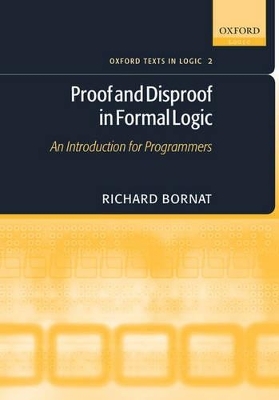
Proof and Disproof in Formal Logic
An Introduction for programmers
Seiten
2005
Oxford University Press (Verlag)
978-0-19-853027-5 (ISBN)
Oxford University Press (Verlag)
978-0-19-853027-5 (ISBN)
Introducing formal logic, this book provides insight into how a simple logic works. It concentrates on using logic as a tool, and is divided in to four parts. Aimed at undergraduates and graduates in computer science, logic, mathematics, and philosophy, this text includes reference to and exercises based on the computer software package Jape.
Proof and Disproof in Formal Logic is a lively and entertaining introduction to formal logic providing an excellent insight into how a simple logic works. Formal logic allows you to check a logical claim without considering what the claim means. This highly abstracted idea is an essential and practical part of computer science. The idea of a formal system--a collection of rules and axioms which define a universe of logical proofs--is what gives us programming languages and modern-day programming.
This book concentrates on using logic as a tool: making and using formal proofs and disproofs of particular logical claims. The logic it uses--natural deduction--is very small and very simple; working with it helps you see how large mathematical universes can be built on small foundations.
The book is divided into four parts:
· Part I "Basics" gives an introduction to formal logic with a short history of logic and explanations of some technical words.
· Part II "Formal syntactic proof" show you how to do calculations in a formal system where you are guided by shapes and never need to think about meaning. Your experiments are aided by Jape, which can operate as both inquisitor and oracle.
· Part III "Formal semantic disproof" shows you how to construct mathematical counterexamples to show that proof is impossible. Jape can check the counterexamples you build.
· Part IV "Program specification and proof" describes how to apply your logical understanding to a real computer science problem, the accurate description and verification of programs. Jape helps, as far as arithmetic allows.
Aimed at undergraduates and graduates in computer science, logic, mathematics, and philosophy, the text includes reference to and exercises based on the computer software package Jape, an interactive teaching and research tool designed and hosted by the author that is freely available on the web.
Proof and Disproof in Formal Logic is a lively and entertaining introduction to formal logic providing an excellent insight into how a simple logic works. Formal logic allows you to check a logical claim without considering what the claim means. This highly abstracted idea is an essential and practical part of computer science. The idea of a formal system--a collection of rules and axioms which define a universe of logical proofs--is what gives us programming languages and modern-day programming.
This book concentrates on using logic as a tool: making and using formal proofs and disproofs of particular logical claims. The logic it uses--natural deduction--is very small and very simple; working with it helps you see how large mathematical universes can be built on small foundations.
The book is divided into four parts:
· Part I "Basics" gives an introduction to formal logic with a short history of logic and explanations of some technical words.
· Part II "Formal syntactic proof" show you how to do calculations in a formal system where you are guided by shapes and never need to think about meaning. Your experiments are aided by Jape, which can operate as both inquisitor and oracle.
· Part III "Formal semantic disproof" shows you how to construct mathematical counterexamples to show that proof is impossible. Jape can check the counterexamples you build.
· Part IV "Program specification and proof" describes how to apply your logical understanding to a real computer science problem, the accurate description and verification of programs. Jape helps, as far as arithmetic allows.
Aimed at undergraduates and graduates in computer science, logic, mathematics, and philosophy, the text includes reference to and exercises based on the computer software package Jape, an interactive teaching and research tool designed and hosted by the author that is freely available on the web.
PART I BASICS; PART II FORMAL PROOF; PART III DISPROOF; PART IV PROOF OF PROGRAMS
| Erscheint lt. Verlag | 21.7.2005 |
|---|---|
| Reihe/Serie | Oxford Texts in Logic ; Vol.2 |
| Zusatzinfo | numerous line drawings and mathematical examples |
| Verlagsort | Oxford |
| Sprache | englisch |
| Maße | 169 x 240 mm |
| Gewicht | 473 g |
| Themenwelt | Mathematik / Informatik ► Informatik ► Theorie / Studium |
| Mathematik / Informatik ► Mathematik ► Allgemeines / Lexika | |
| Mathematik / Informatik ► Mathematik ► Computerprogramme / Computeralgebra | |
| Mathematik / Informatik ► Mathematik ► Logik / Mengenlehre | |
| ISBN-10 | 0-19-853027-7 / 0198530277 |
| ISBN-13 | 978-0-19-853027-5 / 9780198530275 |
| Zustand | Neuware |
| Haben Sie eine Frage zum Produkt? |
Mehr entdecken
aus dem Bereich
aus dem Bereich
was jeder über Informatik wissen sollte
Buch | Softcover (2024)
Springer Vieweg (Verlag)
37,99 €
Grundlagen – Anwendungen – Perspektiven
Buch | Softcover (2022)
Springer Vieweg (Verlag)
34,99 €
Eine Einführung in die Systemtheorie
Buch | Softcover (2022)
UTB (Verlag)
25,00 €


